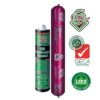MS Polymer Joint Sealant/Adhesive
From $15.80
MS Polymer Sealant/Adhesive Alseal AS-4001
Description
 MS Polymer Joint Sealant/Adhesive AS-4001 is a single-component, high-performance hybrid sealant based on advanced MS Polymer technology. It is formulated to meet the stringent requirements of various joint sealing applications.
MS Polymer Joint Sealant/Adhesive AS-4001 is a single-component, high-performance hybrid sealant based on advanced MS Polymer technology. It is formulated to meet the stringent requirements of various joint sealing applications.
Unlike Polyurethane sealants, its weathering resistance property is much better. Therefore it has a longer service lifetime. Also, its solvent-less and isocyanate-free formulation ensures that the cured sealant will not shrink or have bubbling issues.
MS Polymer Sealant free of silicone oil. It minimizing building aesthetic issues caused by oil-staining and dirt-streaking problems often associated with silicone sealants. The adhesion of the sealant on a wide variety of substrates is great, and it is paintable with most types of common industrial paints.
Features
- Environmentally Friendly Sealant
- ±50 % Movement capability
- LEED compliant
- Better weathering resistance than PU sealants
- Paintable
- Low static charge – Less dirt streaking
- No silicone oil – Non-staining on adjacent substrates
- No isocyanate – No blistering
- No solvent – No shrinkage
- Bonds most substrates without primer
Applications
Recommended for sealing concrete joints like precast wall panel joints, expansion joints, control joints, connection joints, etc. It is also ideal for window frame perimeter sealing especially when the sealant needs to be paint. Other recommended applications include sealing of GRC panel systems, anodized aluminum, masonry, porcelain, coated metal, finished wood, epoxy and polyester panels, UPVC, polystyrene, and stainless steel.
Approvals/Specifications
MS Polymer Joint Sealant/Adhesive Alseal AS-4001 meets the requirements of the following specifications:
- ASTM C920, Type S, Grade NS, Class 50, use NT & M
- Leadership in Energy and Environmental Design (LEED) v4.1 EQ compliant
- ISO 11600 F Class 25 LM
- Good Environmental Choice Australia (GECA) certified
- FDA 21 CFR Part 175.300 compliant – Safe for Food Contact
- Low VOC – USEPA Method 24 under SCAQMD Rule 1168
Usage Instructions
- Surfaces must be clean, dry and free of dirt, grease, oil or water.
- Surfaces should be cleaned with alcohol, M.E.K. or other suitable solvent. Do not use soap or detergent.
- For a neat finishing, apply masking tape and remove it before sealant skins over.
- 602 Primer is recommended for porous substrates such as concrete for excellent adhesion.
- Cut the tip off and puncture the internal foil seal with the nozzle. Cut the nozzle at 45° angle to desired bead-width and apply the sealant to substrate with a cartridge gun.
- Tool the sealant before it skins.
- Wet sealant can be cleaned up with mineral spirits.
- Use approved backing material for joints over 10 mm deep.
Clean Up
- Wet sealants easy to clean up use acetone or mineral spirits.
- Cured sealants can only be removed mechanically.
Limitation
Not recommended for the following applications:
- Below waterline or permanent water immersion.
- Outdoor sealing/bonding adjacent to glass substrates.
- Polyethylene, polypropylene, polytetrafluoroethylene (Teflon), neoprene, and bituminous surfaces.
- Overcoated with:
- Alkyd resin paint – cure inhibition to the paint
- Chlorinated paint – staining issue
Additional information
| Weight | N/A |
|---|---|
| Dimensions | N/A |
| Color | Black, Grey, Teak, White, Concrete Grey, Off White, Sandstone |
| Package | 20 pcs sausages box, Sausage |
Technical Data

Application instruction
Joint Design
- Joint dimension should be designed by taking into consideration the movement capability of the sealant and the anticipated joint movement
- Generally the joint width-to-depth ratio is 2:1 for joint width ≥12 mm, or 1:1 for joint width <12 mm
- Joint width: minimum = 6 mm, maximum = 35 mm
- Joint depth: minimum = 6 mm, maximum = 12 mm
- Sealing joints with larger joint width is possible but sealant may sag in vertical applications.

The coverage figures shown above are approximate linear meter run based on 10% wastage assumption. Actual coverage may vary.
- Calculation formula: X / [(Y x Z) x 1.1] = Coverage
X = volume of cartridge (or sausage) in ml,
Y = joint width in cm, Z = joint depth in cm,
1.1 = 10% wastage assumption,
Coverage = linear meter run in cm per cartridge























